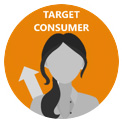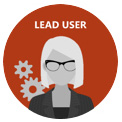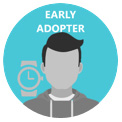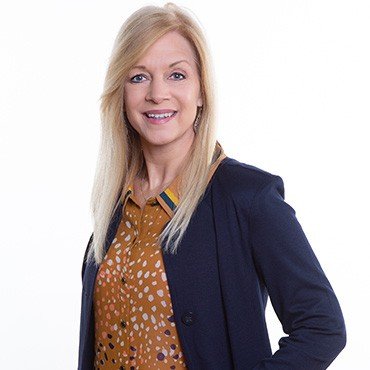
Editor’s Note: If you’re attending the 2018 Corporate Researchers Conference, please join Gwen Ishmael and Paul Ponsford of Delta Faucet Company for “#TomBradyFail—An Innovation Lesson from the New England Patriots” on Wednesday, October 10. Their talk will dive deep into this blog topic of how different consumer types can support (or inhibit) innovation. Contact us for a registration discount code.
As noted in Forging a Clear PATH to Corporate Innovation, it is critical to involve the right types of consumers at the right points along the Innovation Journey. Instead of simply focusing on your Target Consumer, it is important to recognize how other types of consumers—Lead Users, Creatives, Early Adopters and Brand Advocates—can contribute to and strengthen the innovation process.
These different consumer research groups form naturally around shared traits and preferences, the exact kind of commonalities that can spell gold for marketers—and market researchers. But the keys to tapping into their potential lie in understanding and identifying members of each group and knowing when exactly in the Innovation Journey they can contribute most.
Understanding and Identifying Different Types of Consumers
The first step in utilizing consumers during the Innovation Journey is to accurately identify the critical consumer groups. When identifying each consumer type it is important to look at both behaviors and attitudinal beliefs.
 Target Consumers: Consumers your brand is focused on Target Consumers: Consumers your brand is focused onWe’re all familiar with this group—they’re the consumers your company has identified as the targets for your offerings and marketing efforts. They’re critical to successful innovation, but they can’t do it alone. |
 Lead Users: Consumers who can spot problems and opportunities Lead Users: Consumers who can spot problems and opportunitiesLead Users are introspective consumers who tend to recognize something is missing long before others—essentially they spot the gaps. Their needs and desires often conflict with those of Early Adopters and Brand Advocates. Lead Users don’t care about being first and are not loyal to companies or brands but are more interested in achieving their objectives and goals. They may create their own solutions instead of waiting for them to become available commercially. When working with Lead Users it is important to keep in mind that they tend to be highly critical and feel they know best, so take their direction with a grain of salt. |
 Creatives: Imaginative consumers who are skilled at providing options and ideas Creatives: Imaginative consumers who are skilled at providing options and ideasCreatives demonstrate the ability to generate lots of highly unique ideas for new innovative products and services. They may or may not have “traditional” creative abilities in areas such as art, design or music, but generally they have a wide breadth of interests. They’re able to transfer these creative abilities across categories and industries, making them a perfect starting point for concept development. Most creatives are not comfortable following the rules of research and therefore require a less structured approach to unlock their potential. |
 Early Adopters: Consumers who are open to new things Early Adopters: Consumers who are open to new thingsEarly Adopters embrace new products or services sooner than their peers. They’re open-minded and are willing to take some risk and potentially be inconvenienced by new products or experiences. They like to stay informed and are willing to pay a premium to be first. Because Early Adopters tend to dabble with products and move on quickly, we must be careful when projecting their thoughts and feelings onto Target Consumers. |
 Brand Advocates: Consumers who love the brand Brand Advocates: Consumers who love the brandBrand Advocates are strongly positive about a brand, so they are loyal and engage in longer relationships with their favored products. They may share their perceptions with friends and family via social media or word-of-mouth interactions. Exercise caution when working with Brand Advocates as their objectivity can be questionable and they may support new offerings from their favorite brands without having tried them. |
When to Collaborate with the Different Types of Consumers
In order to get the most benefit out of working with different types of consumers, it is critical to involve them at the right points along the Innovation Journey.
The journey can take many forms, depending on the type of product or service being developed. Some organizations take a stage-gating approach, others follow a BAH (Booz Allen Hamilton) or PDMA (Product Development and Management Association) method. For the sake of simplicity, we’ve constructed a five-step journey framework that aligns with most new product development approaches:
- Search – This is where discovery takes place. The objective is to understand consumers’ needs, the jobs they want done, and the gaps that exist in the market. Lead Users are ideal for this phase because of their ability to identify underlying problems and areas of opportunities for the brand to explore. It’s also beneficial to engage Target Consumers who can provide the everyday user’s point of view.
- Develop – Here, ideas are generated, concepts developed and solutions constructed to address the opportunities and gaps in unique and meaningful ways. This is where Creatives come into play. While Target Consumers struggle to offer ideas that go beyond simple, incremental changes to existing products, Creatives can offer the depth and breadth of ideas needed to feed the new product pipeline.
- Validate – In this step, the goal is to confirm the direction being taken is on target, and the product or service being developed resonates. Both Lead Users and Target Consumers can help, since each brings a different point of view to the evaluation and refinement process. Lead Users can spot potential problems others overlook—a critical trait for evaluating these early concepts—while Target Consumers bring the voice of market reality into the picture.
- Launch – Before going to market, it is important to understand how the product or service should be positioned and supported as well as where and how it should be offered. Of course, Target Consumers should be involved since they are your market, but Early Adopters can play a role as well. They represent your early-in consumers and their willingness to buy into a new product or service is a first indicator of success. When it comes to developing messages that activate, Brand Advocates are ideal partners. They are your word-of-mouth drivers—get them on board and they’ll let others know.
- Manage – Here, the goal is to enable the product or service to achieve its objectives and optimize its contributions to the brand. Sometimes a product or service can move through its lifecycle with relatively minor adjustments; other times a full redesign and relaunch could be required. Exactly which consumers to engage depends on how well the product or service is performing. In cases where things are going well and only slight modifications are needed, working with Target Consumers often is sufficient. However, if a product or service is not living up to expectations, collaborating with Lead Users could be appropriate and the Innovation Journey begins again.
If the idea of working with Lead Users, Creatives, Early Adopters, Brand Advocates and Target Consumers intrigues you and you’re interested in learning more about how Escalent can help your Innovation Journey, send us a note.
Special thanks to Gwen Ishmael for her contribution to this blog post!









